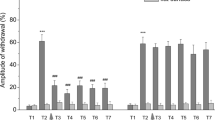Abstract
Levels of the acidic brain-specific Rf = 0.58 protein in neurons of the subglottal complex of ganglia were studied in the common snail during the process of acquisition of defensive food aversion. Levels were significantly increased in neurons LPa3 and RPa3 at both the early and late stages of learning. There was a tendency to increased protein levels in neurons LPl1 and RPl2, while there were no changes in levels in neuron RPa5 and pool D. The level of involvement of defensive behavior command neurons appears to be determined by the specific involvement of their receptor and effector fields.
Similar content being viewed by others
REFERENCES
P. M. Balaban, O. A. Maksimova, and N. M. Bravarenko, “Plastic forms of behavior in the common snail and their neuronal mechanisms,” Zh. Vyssh. Nerv. Deyat., 42, No. 6, 1208–1220 (1992).
V. A. Berezin and Ya. V. Belik, “Specific proteins of nerve tissues,” Kiev. Naukova Dumka (1990).
Yu. D. Bogdanov, D. A. Ovchinnikov, P. M. Balaban, and A. V. Belyavskii, “HCS1 - a new gene specific for giant interneurons in the pleural and parietal ganglia of the nervous system of the common snail Helix lucorum,” Dokl. Ros. Akad. Nauk., 335, No. 2, 246–250 (1993).
L. N. Grinkevich, O. G. Safronova, and M. B. Shtark, “Water-soluble proteins of the subglottal complex of the ganglia of the common snail at the early stages of learning,” Byull. Éksperim. Biol. Med., 10, 429–431 (1984).
L. N. Grinkevich, “Dynamics of the incorporation of [3H]leucine into CNS proteins in the common snail during learning,” Neirokhim., 8, No. 1, 56–63 (1989).
L. N. Grinkevich, “Protein metabolism during formation of conditioned reflexes in mollusks,” Zh. Vyssh. Nerv. Deyat., 42, No. 6, 1221–1229 (1992).
L. N. Grinkevich, P. D. Lisachev, and M. B. Shtark, “Neurochemical correlates of plasticity,” Zh. Vyssh. Nerv. Deyat., 43, No. 5, 963–968 (1993).
V. A. Dyatlov and A. V. Platoshin, “The effects of calcium ions on acetylcholine-induced currents in mollusk neurons,” Neirofiziolog., 22, No. 4, 553–556 (1990).
V. A. Dyatlov, “The role of calcium ions in serotonin-mediated processes modulating the responses of common snail neurons to application of acetylcholine,” Neirofiziologiya, 20, No. 5, 666–671 (1988).
S. G. El'nikova and M. V. Starostina, “Neurospecific proteins in the molecular mechanisms of neuronal plasticity,” Usp. Sovrem. Biologii, 114, No. 3, 319–329 (1994).
Immunological Analysis [in Russian], Nauka, Moscow (1968).
O. A. Maksimova and P. M. Balaban, Neuronal Mechanisms of Behavioral Plasticity [in Russian], Nauka, Moscow (1983).
V. P. Nikitin, S. A. Kozyrev, and M. O. Samoilov, “Conditioning and sensitization in the common snail: neurophysiological and metabolic characteristics,” Zh. Vyssh. Nerv. Deyat., 42, No. 6, 1260–1270 (1992).
O. G. Safronov, “Studies of water-soluble and membrane proteins of the central nervous system of the common snail at different stages of long-term sensitization,” Byull. Éksperim. Biol. Med., 103, No. 3, 266–268 (1987).
T. M. Turpaev, O. P. Yurchenko, and K. Sh. Rozsa, “Two types of interaction between serotonin and acetylcholine in identified neurons in the brain of the common snail,” Dokl. Akad. Nauk. SSSR, 270, No. 6, 1505–1508 (1983).
M. B. Shtark, Brain-Specific Proteins (Antigens) and Neuron Functions [in Russian], Meditsina, Moscow (1985).
Yu. D. Bogdanov, P. M. Balaban, D. A. Poteryaev, I. S. Zakharov, and A. V. Belyavsky, “Putative neuropeptides and an EF-band vjnif region are encoded by a novel gene expressed in the four giant interneurons of the terrestrial snail CNS,” Neuroscience, 2, 61–69 (1998).
O. P. Yurchenko and K. Rozsa, “Modulatory effect of serotonin on the acetylcholine sensitivity of identifies neurons in the brain of Helix pomatia, L.,” Comp. Biochem. Physiol., 77, No. 1, 127–133 (1984).
Author information
Authors and Affiliations
Rights and permissions
About this article
Cite this article
Glushchenko, T.S., Grinkevich, L.N. Studies of the Rf = 0.58 Protein in Common Snail Command Neurons during Learning. Neurosci Behav Physiol 33, 49–52 (2003). https://doi.org/10.1023/A:1021127314745
Issue Date:
DOI: https://doi.org/10.1023/A:1021127314745



